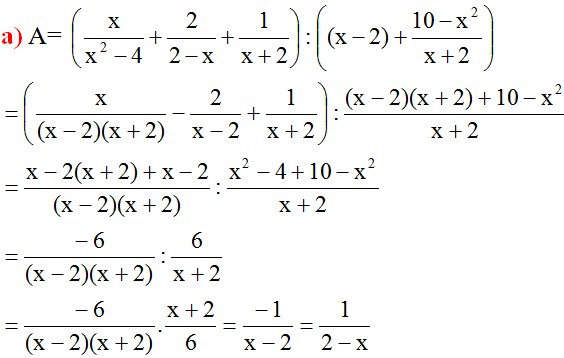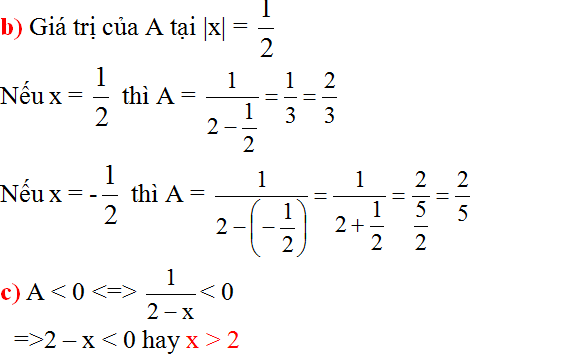Hãy nhập câu hỏi của bạn vào đây, nếu là tài khoản VIP, bạn sẽ được ưu tiên trả lời.

\(1.\)
\(a.\)
\(\dfrac{8}{\left(x^2+3\right)\left(x^2-1\right)}+\dfrac{2}{x^2+3}+\dfrac{1}{x+1}\)
\(=\dfrac{8}{\left(x^2+3\right)\left(x^2-1\right)}+\dfrac{2\left(x^2-1\right)}{\left(x^2+3\right)\left(x^2-1\right)}+\dfrac{1\left(x-1\right)\left(x^2+3\right)}{\left(x^2-1\right)\left(x^2+3\right)}\)
\(=\dfrac{8}{\left(x^2+3\right)\left(x^2-1\right)}+\dfrac{2x^2-2}{\left(x^2+3\right)\left(x^2-1\right)}+\dfrac{x^3-x^2+3x-3}{\left(x^2-1\right)\left(x^2+3\right)}\)
\(=\dfrac{8+2x^2-2+x^3-x^2+3x-3}{\left(x^2+3\right)\left(x^2-1\right)}\)
\(=\dfrac{x^3+x^2+3x+3}{\left(x^2+3\right)\left(x^2-1\right)}\)
\(=\dfrac{x^2\left(x+1\right)+3\left(x+1\right)}{\left(x^2+3\right)\left(x^2-1\right)}\)
\(=\dfrac{\left(x^2+3\right)\left(x+1\right)}{\left(x^2+3\right)\left(x^2-1\right)}\)
\(=x-1\)
\(b.\)
\(\dfrac{x+y}{2\left(x-y\right)}-\dfrac{x-y}{2\left(x+y\right)}+\dfrac{2y^2}{x^2-y^2}\)
\(=\dfrac{x+y}{2\left(x-y\right)}-\dfrac{x-y}{2\left(x+y\right)}+\dfrac{2y^2}{\left(x-y\right)\left(x+y\right)}\)
\(=\dfrac{\left(x+y\right)^2}{2\left(x^2-y^2\right)}-\dfrac{\left(x-y\right)^2}{2\left(x^2-y^2\right)}+\dfrac{4y^2}{2\left(x^2-y^2\right)}\)
\(=\dfrac{x^2+2xy+y^2}{2\left(x^2-y^2\right)}-\dfrac{x^2-2xy+y^2}{2\left(x^2-y^2\right)}+\dfrac{4y^2}{2\left(x^2-y^2\right)}\)
\(=\dfrac{x^2+2xy+y^2-x^2+2xy-y^2+4y^2}{2\left(x^2-y^2\right)}\)
\(=\dfrac{4xy+4y^2}{2\left(x^2-y^2\right)}\)
\(=\dfrac{4y\left(x+y\right)}{2\left(x^2-y^2\right)}\)
\(=\dfrac{2y}{\left(x-y\right)}\)
Tương tự các câu còn lại

a) \(\dfrac{2}{3x+9}-\dfrac{x-3}{3x^2+9x}\)
\(=\dfrac{2}{3\left(x+3\right)}-\dfrac{x-3}{3x\left(x+3\right)}\)
\(=\dfrac{2x}{3x\left(x+3\right)}-\dfrac{x-3}{3x\left(x+3\right)}\)
\(=\dfrac{2x-x+3}{3x\left(x+3\right)}\)
\(=\dfrac{x+3}{3x\left(x+3\right)}\)
\(=\dfrac{1}{3x}\)
b) \(\dfrac{x^2+x}{5x^2-10x+5}:\dfrac{3x+3}{5x-5}\)
\(=\dfrac{x\left(x+1\right)}{5\left(x^2-2x+1\right)}:\dfrac{3\left(x+1\right)}{5\left(x-1\right)}\)
\(=\dfrac{x\left(x+1\right)}{5\left(x-1\right)^2}:\dfrac{3\left(x+1\right)}{5\left(x-1\right)}\)
\(=\dfrac{x\left(x+1\right)}{5\left(x-1\right)^2}.\dfrac{5\left(x-1\right)}{3\left(x+1\right)}\)
\(=\dfrac{x}{\left(x-1\right).3}\)
\(=\dfrac{x}{3x-3}\)
c) \(\dfrac{1}{x\left(x+1\right)}+\dfrac{1}{\left(x+1\right)\left(x+2\right)}+...+\dfrac{1}{\left(x+99\right)\left(x+100\right)}\)
\(=\dfrac{1}{x}-\dfrac{1}{x+1}+\dfrac{1}{x+1}-\dfrac{1}{x+2}+...+\dfrac{1}{x+99}-\dfrac{1}{x+100}\)
\(=\dfrac{1}{x}-\dfrac{1}{x+100}\)
\(=\dfrac{x+100}{x\left(x+100\right)}-\dfrac{x}{x\left(x+100\right)}\)
\(=\dfrac{x+100-x}{x\left(x+100\right)}\)
\(=\dfrac{100}{x\left(x+100\right)}\)

Lời giải của bạn Nhật Linh đúng rồi, tuy nhiên cần thêm điều kiện để A có nghĩa: \(x\ne\pm2\)

bai 1
a) \(\left|x+\dfrac{4}{15}\right|-\left|-3,75\right|=-\left|2,15\right|\)
\(\left|x+\dfrac{4}{15}\right|-3,75=-2,,15\)
\(\left|x+\dfrac{4}{15}\right|=-2,15+3,75=1,6\)
\(\Rightarrow\left[{}\begin{matrix}x+\dfrac{4}{15}=1,6\\x+\dfrac{4}{15}=-1,6\end{matrix}\right.\Leftrightarrow\left[{}\begin{matrix}x=\dfrac{4}{3}\\x=-\dfrac{28}{15}\end{matrix}\right.\)
Vậy ....
b) \(\left|\dfrac{5}{3}x\right|=\left|-\dfrac{1}{6}\right|\)
\(\left|\dfrac{5}{3}x\right|=\dfrac{1}{6}\)
\(\Rightarrow\left[{}\begin{matrix}\dfrac{5}{3}x=-\dfrac{1}{6}\\\dfrac{5}{3}x=\dfrac{1}{6}\end{matrix}\right.\Rightarrow\left[{}\begin{matrix}x=-\dfrac{1}{10}\\x=\dfrac{1}{10}\end{matrix}\right.\)
c) \(\left|\dfrac{3}{4}x-\dfrac{3}{4}\right|-\dfrac{3}{4}=\left|-\dfrac{3}{4}\right|\)
\(\left|\dfrac{3}{4}x-\dfrac{3}{4}\right|-\dfrac{3}{4}=\dfrac{3}{4}\)
\(\left|\dfrac{3}{4}x-\dfrac{3}{4}\right|=\dfrac{3}{2}\)
\(\Rightarrow\left[{}\begin{matrix}\dfrac{3}{4}x-\dfrac{3}{4}=\dfrac{3}{2}\\\dfrac{3}{4}x-\dfrac{3}{4}=-\dfrac{3}{2}\end{matrix}\right.\Rightarrow\left[{}\begin{matrix}x=3\\-1\end{matrix}\right.\)
bai 2
a) \(\left|\dfrac{1}{2}-\dfrac{1}{3}+x\right|=\dfrac{1}{4}-\left|y\right|\)
\(\left|\dfrac{1}{6}+x\right|=\dfrac{1}{4}-\left|y\right|\) (*)
với mọi x ta luôn có \(\left|\dfrac{1}{6}+x\right|\ge0\)
\(\Rightarrow\dfrac{1}{4}-\left|y\right|\ge0\)
\(\Rightarrow\left|y\right|\le\dfrac{1}{4}\) \(\Rightarrow\dfrac{1}{4}-\left|y\right|=\left|\dfrac{1}{4}-y\right|\)
Nên từ * \(\Rightarrow\left|\dfrac{1}{6}+x\right|=\left|\dfrac{1}{4}-y\right|\)
\(\Rightarrow\left|\dfrac{1}{6}+x\right|-\left|\dfrac{1}{4}-y\right|=0\)
\(\Rightarrow\left\{{}\begin{matrix}\dfrac{1}{6}+x=0\\\dfrac{1}{4}-y=0\end{matrix}\right.\Rightarrow\left\{{}\begin{matrix}x=-\dfrac{1}{6}\\y=\dfrac{1}{4}\end{matrix}\right.\)
b) \(\left|x-y\right|+\left|y+25\right|=0\)
với mọi x, y tao luôn có \(\left\{{}\begin{matrix}\left|x-y\right|\ge0\\\left|y+25\right|\ge0\end{matrix}\right.\)
mà \(\left|x-y\right|+\left|y+25\right|=0\)
\(\Rightarrow\left\{{}\begin{matrix}\left|x-y\right|=0\\\left|y+25\right|=0\end{matrix}\right.\Rightarrow\left\{{}\begin{matrix}x=y\\y=-25\end{matrix}\right.\Rightarrow}\left\{{}\begin{matrix}x=-25\\y=-25\end{matrix}\right.\)

\(a=\left(x-2\right)\left(x-4\right)\left(x^2-6x+10\right)\)
\(a=\left[x\left(x-4\right)-2\left(x-4\right)\right]\left(x^2-6x+10\right)\)
\(a=\left(x^2-4x-2x+8\right)\left(x^2-6x+10\right)\)
\(a=\left(x^2-6x+8\right)\left(x^2-6x+10\right)\)
\(a=\left(x^2-6x+9-1\right)\left(x^2-6x+9+1\right)\)
\(a=\left(x^2-6x+9\right)^2-1\ge-1\)
Dấu "=" xảy ra khi:
\(x^2-6x+9=0\)
\(\Rightarrow x^2-3x-3x+9=0\)
\(\Rightarrow x\left(x-3\right)-3\left(x-3\right)=0\)
\(\Rightarrow\left(x-3\right)^2=0\Leftrightarrow x=3\)
\(b=\dfrac{20}{60x-9x^2-21}\)
\(b=\dfrac{20}{-9x^2+60x-21}\)
\(b=\dfrac{20}{-\left(9x^2-60x+21\right)}\)
\(b=\dfrac{20}{-\left(9x^2-60x+100-79\right)}\)
\(b=\dfrac{20}{-\left(9x^2-60x+100\right)+79}\)
\(b=\dfrac{20}{-\left(3x-10\right)^2+79}\le-\dfrac{20}{79}\)
Dấu "=" xảy ra khi: \(x=\dfrac{10}{3}\)

1)
\(\dfrac{x-5}{100}+\dfrac{x-4}{101}+\dfrac{x-3}{102}=\dfrac{x-100}{5}+\dfrac{x-101}{4}+\dfrac{x-102}{3}\)
\(\Leftrightarrow\dfrac{x-5}{100}+1+\dfrac{x-4}{101}+1+\dfrac{x-3}{102}+1=\dfrac{x-100}{5}+1+\dfrac{x-101}{4}+1+\dfrac{x-102}{3}+1\)
\(\Leftrightarrow\dfrac{x-105}{100}+\dfrac{x-105}{101}+\dfrac{x-105}{102}=\dfrac{x-105}{5}+\dfrac{x-105}{4}+\dfrac{x-105}{3}+\dfrac{x-105}{2}\)
\(\Leftrightarrow\dfrac{x-105}{100}+\dfrac{x-105}{101}+\dfrac{x-105}{102}-\dfrac{x-105}{5}-\dfrac{x-105}{4}-\dfrac{x-105}{3}-\dfrac{x-105}{2}=0\)
\(\Leftrightarrow\left(x-105\right)\left(\dfrac{1}{100}+\dfrac{1}{101}+\dfrac{1}{102}-\dfrac{1}{5}-\dfrac{1}{4}-\dfrac{1}{3}-\dfrac{1}{2}\right)=0\)\(\Leftrightarrow105-x=0\)
\(\Leftrightarrow x=105\)
b)
\(\dfrac{29-x}{21}+\dfrac{27-x}{23}+\dfrac{25-x}{25}+\dfrac{23-x}{27}+\dfrac{21-x}{29}=0\)
\(\Leftrightarrow\dfrac{29-x}{21}+1+\dfrac{27-x}{23}+1+\dfrac{25-x}{25}+1+\dfrac{23-x}{27}+1+\dfrac{21-x}{29}+1=0\)
\(\Leftrightarrow\dfrac{50-x}{21}+\dfrac{50-x}{23}+\dfrac{50-x}{25}+\dfrac{20-x}{27}+\dfrac{50-x}{29}=0\)
\(\Leftrightarrow\left(50-x\right)\left(\dfrac{1}{21}+\dfrac{1}{23}+\dfrac{1}{25}+\dfrac{1}{27}+\dfrac{1}{29}\right)=0\)
\(\Leftrightarrow50-x=0\)
\(\Leftrightarrow x=50\)
2)
\(\left(5x+1\right)^2=\left(3x-2\right)^2\)
\(\Leftrightarrow\left|5x+1\right|=\left|3x-2\right|\)
\(\Leftrightarrow\left[{}\begin{matrix}5x+1=3x-2\\5x+1=-3x+2\end{matrix}\right.\)
\(\Leftrightarrow\left[{}\begin{matrix}x=\dfrac{-3}{2}\\x=\dfrac{1}{8}\end{matrix}\right.\)
b) \(\left(x+2\right)^3=\left(2x+1\right)^3\)
\(\Leftrightarrow x^3+6x^2+12x+8=8x^3+12x^2+6x+1\)
\(\Leftrightarrow-7x^3-6x^2+6x+7=0\)
\(\Leftrightarrow-7x^3+7x^2-13x^2+13x-7x+7=0\)
\(\Leftrightarrow-7x^2\left(x-1\right)-13x\left(x-1\right)-7\left(x-1\right)=0\)
\(\Leftrightarrow\left(x-1\right)\left(-7x^2-13x-7\right)=0\)
\(\Leftrightarrow\left[{}\begin{matrix}x-1=0\\-7x^2-13x-7=0\end{matrix}\right.\)
\(\Leftrightarrow\left[{}\begin{matrix}x=1\\-7\left(x^2+\dfrac{13}{7}x+1\right)=0\end{matrix}\right.\)
\(\Leftrightarrow\left[{}\begin{matrix}x=1\\-7\left(x+\dfrac{13}{14}\right)^2-\dfrac{169}{196}=0\left(l\right)\end{matrix}\right.\)
\(\Leftrightarrow x=1\)

Lời giải:
Chắc bạn nhầm giữa GTLN và GTNN. Ba biểu thức này chỉ tìm đc min thôi nhé.
Biểu thức 1:
\(A=4x^2+4x+2016=(2x+1)^2+2015\)
Nhận thấy với \(x\in\mathbb{R}\Rightarrow (2x+1)^2\geq 0\Rightarrow (2x+1)^2+2015\geq 2015\)
Do đó \(A_{\min}=2015\Leftrightarrow x=-\frac{1}{2}\)
Biểu thức 2:
\(B=\frac{-7}{x^2+6x+2012}\)
Ta có \(x^2+6x+2012=(x+3)^2+2003\)
Thấy rằng \((x+3)^2\geq 0\forall x\in\mathbb{R}\Rightarrow (x+3)^2+2003\geq 2003\)
\(\Rightarrow \frac{1}{x^2+6x+2012}\leq \frac{1}{2003}\Rightarrow \frac{-7}{x^2+6x+2012}\geq \frac{-7}{2003}\)
\(\Rightarrow B_{\min}=\frac{-7}{2003}\Leftrightarrow x=-3\)
Biểu thức 3:
\(C=(x-1)(x+3)(x+2)(x+6)\)
\(\Leftrightarrow C=[(x-1)(x+6)][(x+2)(x+3)]\)
\(\Leftrightarrow C=(x^2+5x-6)(x^2+5x+6)\)
Đặt \(x^2+5x-6=t\Rightarrow C=t(t+12)=(t+6)^2-36\geq 0-36\)
\(\Leftrightarrow C\geq -36\)
Vậy \(C_{\min}=-36\Leftrightarrow t=-6\Leftrightarrow x^2+5x-6=-6\Leftrightarrow x=0\) hoặc \(x=-5\)

a: \(\Leftrightarrow x^3-3x^2+3x-1-x^3+2x^2-x=5x\left(2-x\right)-11\left(x+2\right)\)
=>-x^2+2x-1=10x-5x^2-11x-22
=>-x^2+2x-1=-5x^2-x-22
=>4x^2+3x+21=0
=>PTVN
b: \(\Leftrightarrow\left(x+10\right)\left(x+4\right)+3\left(x+4\right)\left(x-2\right)=4\left(x+10\right)\left(x-2\right)\)
=>x^2+14x+40+3(x^2+2x-8)=4(x^2+8x-20)
=>x^2+14x+40+3x^2+6x-24=4x^2+32x-80
=>20x+16=32x-80
=>-12x=-96
=>x=8
c: \(\Leftrightarrow6\left(x-3\right)+7\left(x-5\right)=13x+4\)
=>6x-18+7x-35=13x+4
=>-53=4(loại)
d: =>3(2x-1)-5(x-2)=3(x+7)
=>6x-3-5x+10=3x+21
=>3x+21=x+7
=>x=-7
e: =>x^3-6x^2+12x-8-x^3-3x^2-3x-1=-9x^2+1
=>-9x^2+9x-9=-9x^2+1
=>9x=10
=>x=10/9


\(\left(x+y\right)^2\ge4xy\) (1)
Chứng minh : \(x^2-2xy+y^2\ge0\)
\(\Leftrightarrow\left(x-y\right)^2\ge4xy\forall x,y\)
a ) Áp dụng BĐT (1) ta có :
\(\left(x+10\right)^2\ge4.x.10=40x\)
\(\Rightarrow\dfrac{x}{\left(x+10\right)^2}\le\dfrac{x}{40x}=\dfrac{1}{40}\)
Dấu "=" xảy ra khi \(x=10.\)
Câu b tương tự